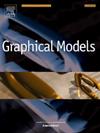SEDFMNet: A Simple and Efficient Unsupervised Functional Map for Shape Correspondence Based on Deconstruction
IF 2.2
4区 计算机科学
Q2 COMPUTER SCIENCE, SOFTWARE ENGINEERING
引用次数: 0
Abstract
In recent years, deep functional maps (DFM) have emerged as a leading learning-based framework for non-rigid shape-matching problems, offering diverse network architectures for this domain. This richness also makes exploring better and novel design beliefs for existing powerful DFM components to promote performance meaningful and engaging. This paper delves into this problem and successfully produces the SEDFMNet, a simple yet highly efficient DFM pipeline. To achieve this, we systematically deconstruct the core modules of the general DFM framework and analyze key design choices in existing approaches to identify the most critical components through extensive experiments. By reassembling these crucial components, we culminate in developing our SEDFMNet, which features a simpler structure than conventional DFM pipelines while delivering superior performance. Our approach is rigorously validated through comprehensive experiments on diverse datasets, where the SEDFMNet consistently achieves state-of-the-art results, even in challenging scenarios such as non-isometric shape matching and shape matching with topological noise. Our work offers fresh insights into DFM research and opens new avenues for advancing this field.

SEDFMNet:一种简单高效的基于解构的形状对应的无监督函数映射
近年来,深度功能图(DFM)已成为非刚性形状匹配问题的主要基于学习的框架,为该领域提供了多种网络架构。这种丰富性还有助于为现有功能强大的DFM组件探索更好和新颖的设计信念,以提高性能的意义和吸引力。本文对这一问题进行了深入的研究,并成功地实现了一种简单而高效的DFM流水线SEDFMNet。为了实现这一目标,我们系统地解构了通用DFM框架的核心模块,并通过广泛的实验分析了现有方法中的关键设计选择,以确定最关键的组件。通过重新组装这些关键组件,我们最终开发出了SEDFMNet,它的结构比传统的DFM管道更简单,同时提供了卓越的性能。我们的方法通过在不同数据集上的综合实验得到了严格的验证,即使在非等距形状匹配和带有拓扑噪声的形状匹配等具有挑战性的场景中,SEDFMNet也始终能够获得最先进的结果。我们的工作为DFM研究提供了新的见解,并为推进这一领域开辟了新的途径。
本文章由计算机程序翻译,如有差异,请以英文原文为准。
求助全文
约1分钟内获得全文
求助全文
来源期刊

Graphical Models
工程技术-计算机:软件工程
CiteScore
3.60
自引率
5.90%
发文量
15
审稿时长
47 days
期刊介绍:
Graphical Models is recognized internationally as a highly rated, top tier journal and is focused on the creation, geometric processing, animation, and visualization of graphical models and on their applications in engineering, science, culture, and entertainment. GMOD provides its readers with thoroughly reviewed and carefully selected papers that disseminate exciting innovations, that teach rigorous theoretical foundations, that propose robust and efficient solutions, or that describe ambitious systems or applications in a variety of topics.
We invite papers in five categories: research (contributions of novel theoretical or practical approaches or solutions), survey (opinionated views of the state-of-the-art and challenges in a specific topic), system (the architecture and implementation details of an innovative architecture for a complete system that supports model/animation design, acquisition, analysis, visualization?), application (description of a novel application of know techniques and evaluation of its impact), or lecture (an elegant and inspiring perspective on previously published results that clarifies them and teaches them in a new way).
GMOD offers its authors an accelerated review, feedback from experts in the field, immediate online publication of accepted papers, no restriction on color and length (when justified by the content) in the online version, and a broad promotion of published papers. A prestigious group of editors selected from among the premier international researchers in their fields oversees the review process.
 求助内容:
求助内容: 应助结果提醒方式:
应助结果提醒方式:


